平成29年04月29日 土曜日号
“万華鏡 平成19年”
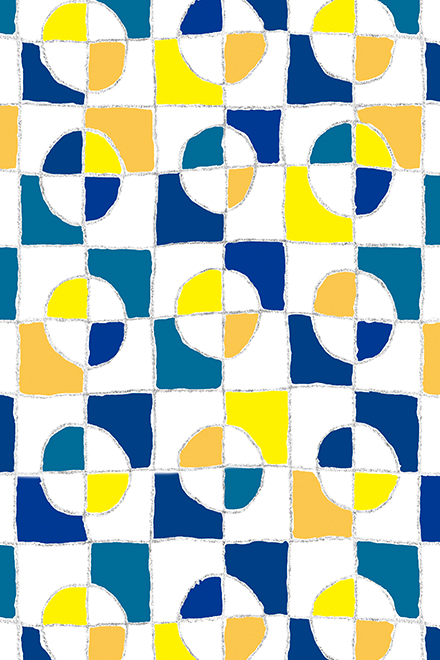
円筒形の筒をのぞきこんでクルクルまわすと
中の模様がどんどん変化していく。
何でもない形がからみあって無限の模様の
世界がくり広げられる。
つかの間の世界を見せてくれる万華鏡。
(脇阪 克二)
"Kaleidoscope"(2007,by Katsuji Wakisaka)
Look into a kaleidoscope,
Turn the little tube,
Materials inside reflected in an endless variety of patterns.
Those colorful broken bits overlapping and recombining,
Showing a world of endless pattern and ephemeral beauty.
| English translation by LI XIAO XIAO |
"Kaléidoscope"(2007, par Katsuji Wakisaka)
En regardant de par son tube cylindrique, On fait défiler des motifs qui évoluent constamment. Des formes quelconques s'entremêlent et un monde de motifs sans fin s'étend devant nos yeux. Un monde éphémère que tu nous montres, Kaléidoscope.
| Traduction française par Jean-Baptiste Fauvel Matsumoto |
"萬花筒"(2007, 脇阪 克二)
眼睛貼近觀察孔,輕輕轉動圓筒
就能看到不斷變化的彩色圖案
這些不起眼的彩色小碎片
重疊交織,變幻出無數圖案
萬花筒展現的是刹那卻充滿無限可能的繽紛小世界
| 中譯 : 李 瀟瀟 |
→こちらのテキスタイルデザイン商品
(Textile products with this pattern)
平成29年04月27日 木曜日号
“花壇 平成25年”
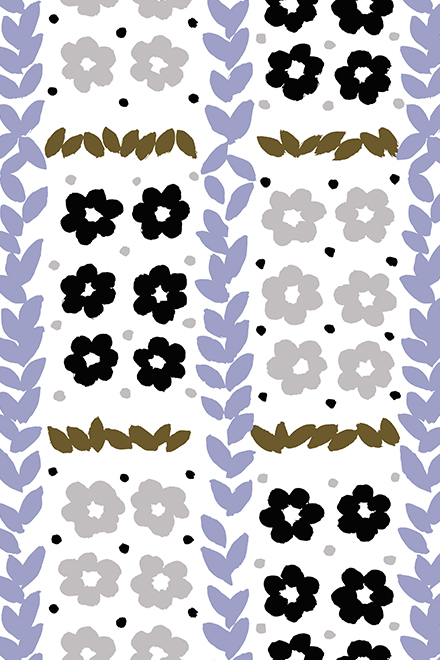
レンガを低く積んだ長方形の花壇に種をまく。
花が開いた時の情景を思い浮べながら配置を決めていく。
毎日少しずつ水をやりながら少しずつ成長していく姿を見守っていく。
そしてある朝、一輪の花が開く。
花や植物を育てるのはその過程全てが楽しく心を豊かにしてくれる。
(脇阪 克二)
"Flower bed"(2013,by Katsuji Wakisaka)
I piling up some bricks to build up a rectangle flower bed.
Sowed some seeds while leaving a place by imagine their blooming.
I watering them every day and watching over their growth.
Suddenly one day,
One of them burst into bloom.
The process of growing flowers or plants is enjoyable and it enrich my mind.
| English translation by LI XIAO XIAO |
"Parterre de fleurs"(2013, par Katsuji Wakisaka)
Je plante des graines dans un long parterre de fleurs emmuré de briques. Je décide de sa configuration en l'imaginant mentalement. Je veille à leur croissance en les arrosant avec parcimonie tous les jours. Puis un jour, une fleur éclôt. Faire pousser des fleurs et des plantes, tout ce processus est un plaisir enrichissant.
| Traduction française par Jean-Baptiste Fauvel Matsumoto |
"花壇"(2013, 胁阪 克二)
在矮磚砌成的花壇裏播種。
一邊想像開花時的情景一邊決定種子的布局。
終于,某個清晨,開出了第一朵花。
種花或是養植物,
過程中每一步都意義非凡,
讓我們內心變得充實。
| 中译 : 李 瀟瀟 |
→こちらのテキスタイルデザイン商品
(Textile products with this pattern)
平成29年04月25日 火曜日号
“薫風 平成29年”


初夏の風が 若葉の香りを
運んでくる 心地いい季節。
源氏香の格子戸のような図柄が
薫風が吹き抜ける さわやかさを
感じさせてくれる。
この源氏香の図柄はシンプル
だけれど 美しく 気品があり
着物や帯 家紋などにも
使われている。
(脇阪 克二)
"Kunpu / Early summer breeze"(2017,by Katsuji Wakisaka)
Early summer time,
Balmy breeze of blow,
With a fresh green fragrance.
It blowing through lattice door with genjiko or genji incense pattern,
Bringing refreshing air of this pleasant season.
Genjiko pattern is simple but graceful, so that it is also commonly seen in kimono, obi or kamon design.
| English translation by LI XIAO XIAO |
"Brise d’été"(2017, par Katsuji Wakisaka)
Les premières brises de l’été apporte l’odeur
Des jeunes pousses des arbres, paisiblement.
Les motifs, tel les lattices de Genjiko, nous
Rappelle les douces brises d’été.
Ces motifs de Genjiko sont simples mais magnifiques,
Remplis de dignité et de beauté, souvent
Utilisées dans la confection des kimonos ou obis.
| Traduction française par Jean-Baptiste Fauvel Matsumoto |
"熏風"(2017, 胁阪 克二)
熏風習習,帶來嫩葉的清香,
在這宜人的時節裡,
熏風穿過源氏香圖案的格子門,
吹來初夏的清爽。
源氏香的圖樣簡單卻雅緻,
因此也常見於和服,和服腰帶,和家紋的設計中。
| 中译 : 李 瀟瀟 |
→こちらのテキスタイルデザイン商品
(Textile products with this pattern)
平成29年04月21日 金曜日号
“花刺繡 平成22年”
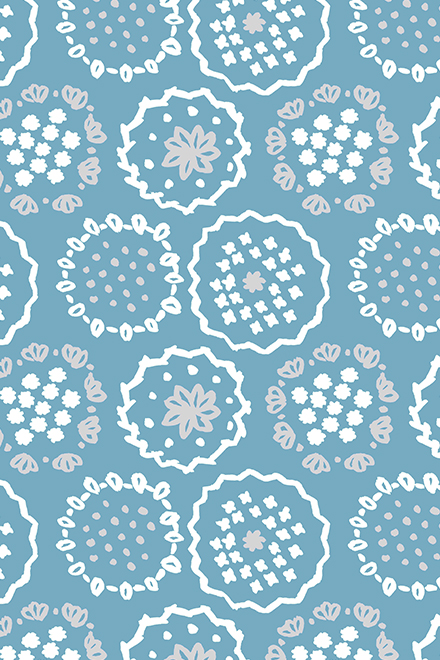
僕はどちらかというと 繊細な
デザインは苦手。大まかで素朴な
感じのものが合っている。
太い糸で刺繍したような
大らかな線で絵描いた花。
(脇阪 克二)
"Flower embroidery"(2010,by Katsuji Wakisaka)
To be honest,
I'm not very good at designing delicate patterns.
Instead, those simple and rough textile design would be easier for me.
Like this "flower embroidery" pattern,
It's just like a embroidery that sewn in thick
| English translation by LI XIAO XIAO |
"Broderie de fleurs"(2010, par Katsuji Wakisaka)
Pour être honnête avec vous, j’éprouve des difficultés
avec les designs fins et délicats.
Les choses simples et grossières me correspondent davantage.
Une fleur dessinée avec un fil épais pour un trait généreux à l'image d'une broderie.
| Traduction française par Jean-Baptiste Fauvel Matsumoto |
"花刺繡"(2010, 脇阪 克二)
比起描繪精巧細致的花紋,
我更擅長創作簡單明快的大花。
這副“花刺繡”正是如此,
好似用粗線繡出一朵朵自由奔放的大花。
| 中譯 : 李 瀟瀟 |
→こちらのテキスタイルデザイン商品
(Textile products with this pattern)
平成29年04月15日 土曜日号
“京(みやこ)の優雅 平成23年”

爛漫と咲き乱れる桜の舞台に華やかな着物を着た
祇園のきれいどころが勢ぞろいする都をどり。
一三○年以上も続いていて、四月の京都には
なくてはならないものになっている。
青い地に桜の模様をあしらった着物で
居並ぶ様は何ともあでやか。
(脇阪 克二)
"Beautiful Kyoto spring"(2011,by Katsuji Wakisaka)
Miyako Odori performance (The geisha dance of the capital) take place in April when the cherry blossoms are in bloom.
It is held for more than 130 years, and exquisite kimono they are wearing is an indispensable scene in spring of Kyoto.
What a graceful thing of those blue kimono decorated with cherry blossoms!
| English translation by LI XIAO XIAO |
"L’élégance Kyotoïte"(2011, par Katsuji Wakisaka)
Miyako Odori, regroupant les beautés de Gion drapées de kimonos
éclatants sur une scène couverte de fleurs de cerisiers magnifiques.
Instaurée depuis plus de 130 ans, elle est devenue indissociable de la ville de Kyoto.
Tant de charme dans ces kimonos bleus à motifs de fleurs de cerisiers!
| Traduction française par Jean-Baptiste Fauvel Matsumoto |
"優雅古都"(2011, 胁阪 克二)
櫻開爛漫,舞妓們身著華美和服,
在祇園絢爛的舞台上,
上演著京都春季風物詩「都をどり」。
這是古都的4月盛景,已有130年以上的曆史。
那些藍底櫻花紋樣的和服,
華麗繁盛而美。
| 中译 : 李 瀟瀟 |
→こちらのテキスタイルデザイン商品
(Textile products with this pattern)
平成29年04月14日 金曜日号
“れんげ草 平成22年”
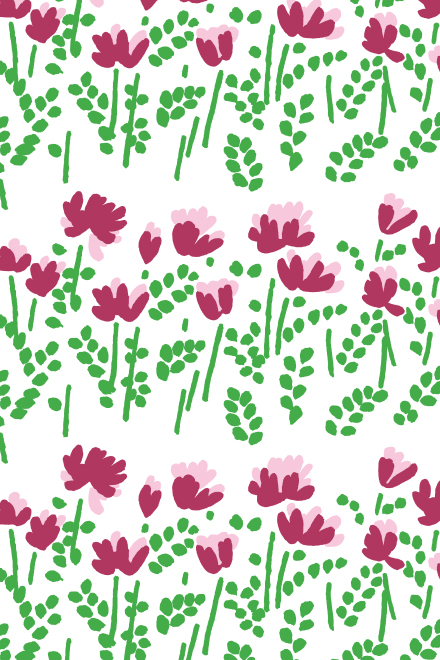
「春の小川はさらさらいくよ、
岸のすみれや れんげの花に…」
と歌われた様に、昔はどこでもれんげの花を見かけた。
僕は京都の街中で育ったので、
いつも見てきたわけではないけれど、
とても親しみを感じる花だ。
(脇阪 克二)
"Milk Vetch Flowers"(2010,by Katsuji Wakisaka)
"The small stream goes whispering between the violets and milk vetches... "
As the song implies, we could see Milk Vetch Flowers almost everywhere.
I was born and raised in Kyoto,
I feel familiar with these flowers even if I didn't see it all the time.
| English translation by LI XIAO XIAO |
"Lotus sacré"(2010, par Katsuji Wakisaka)
"Un petit cours d’eau printanier qui ruissèle,
comme une violette sur la rive, comme une fleur de Lotus…"
Comme l’implique la chanson, on voyait des fleurs de Lotus
un peu partout autrefois.
Comme j’ai passé mon enfance à Kyoto,
je la considère comme une fleur familière,
même si je n’en voyais pas tout le temps.
| Traduction française par Jean-Baptiste Fauvel |
"紫雲英"(2010, 胁阪 克二)
彌生春在《春日小溪》中唱道:
“春日小溪流水聲淙淙/流過岸邊的紫菫和雲英……”
紫雲英一直是一道優雅的春日風景。
我從小在京都長大,紫雲英雖不常見,但也是熟悉的。
| 中译 : 李 瀟瀟 |
→こちらのテキスタイルデザイン商品
(Textile products with this pattern)
平成29年04月12日 水曜日号
“夜桜ひらり 平成18年”
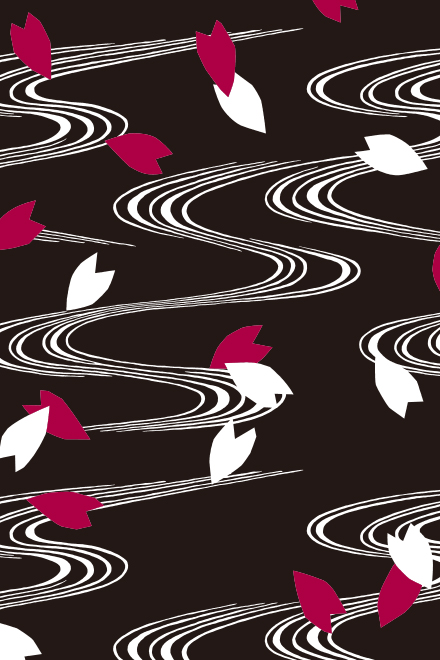
桜は三分咲き、五分咲き、満開とどの瞬間も美しい。
しかしそれにもまして魅力的なのは散っていくとき。
いさぎよく散る姿にもののあわれを感じ、
自分の人生を重ね合わせる。
夜桜がひらひらと舞い散る姿には
妖艶さも加わり一段と美しい。
(脇阪 克二)
"Sakura petals dance in the night"(2006,by Katsuji Wakisaka)
The lovely, amorous cherry blossom lady,
Beautiful in youth, and comely at all periods of life.
She burst into bloom, come into full blossom, and gracefully fall in her most fascinating time.
I always associate her falling with my life.
Sakura petals flutter and hover,
Ravishingly dancing in the night.
| English translation by LI XIAO XIAO |
"Cerisiers nocturnes"(2006, par Katsuji Wakisaka)
Qu'elles soient fleuries partiellement, à moitié ou totalement,
les fleurs de cerisiers sont splendides.
Mais le plus beau spectable reste quand leurs pétales tombent.
À leur vue, une compassion gracieuse nous envahit,
se superposant à nos propres vies.
Il y a quelque chose d’ensorcelant dans ces cerisiers nocturnes
qui se répandent en dansant, les rendant encore plus magnifiques.
| Traduction française par Jean-Baptiste Fauvel Matsumoto |
"夜櫻輕舞"(2006, 胁阪 克二)
櫻花開三分時美,半開也美,盛放時更甚。
但這些都美不過它凋謝的瞬間。
櫻花輕盈飄零的姿態讓我聯想到自己的人生。
夜櫻飛舞,舞姿绰约,香消玉陨百媚生。
| 中译 : 李 瀟瀟 |
平成29年04月08日 土曜日号
“すずしろ草 平成16年”
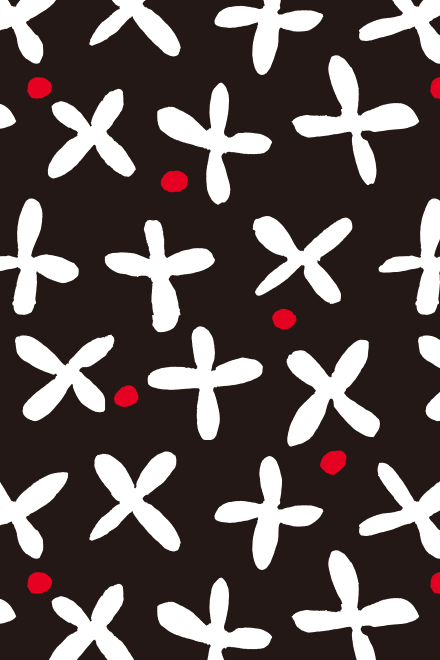
細い体つきだが茎をせいいっぱい伸ばして
真白な四枚の花びらをつけるすずしろ草。
ダイコンの花に似た可憐な花だが
厳しい傾斜地や崖などにも生育するたくましい花。
負けずにがんばろうと思わせてくれる。
(脇阪 克二)
"Small white flowers"(2004,by Katsuji Wakisaka)
These small white flower has slender figure but do all in its strength to grow.
They are with four pedals and resembling Japanese radish flowers in appearance.
Our small fighters are able to live in harsh environments,
Such as hillsides or cliffs.
They motivate me to hang in whenever I come across difficulties.
| English translation by LI XIAO XIAO |
"Arabis flagellosa"(2004, par Katsuji Wakisaka)
Cette fleur a un petit corps mais elle s'efforce de faire
pousser son pédoncule et ses fleurs blanches à quatre pédales.
C'est une fleur magnifique, ressemblant à celle du radis japonais,
et robuste, pouvant vivre dans des environnements difficiles
comme les bord de collines ou les falaises.
Tenez bon sans jamais abandonner, nous rappelle t-elle.
| Traduction française par Jean-Baptiste Fauvel Matsumoto |
"蘿蔔草"(2004, 胁阪 克二)
瘦瘦小小的蘿蔔草,
展開純白的四瓣花瓣,奮力生長。
十字花生命力頑強,在懸崖峭壁也能開出可愛的小花。
蘿蔔草的身影激勵我們堅持不放棄。
| 中译 : 李 瀟瀟 |
→こちらのテキスタイルデザイン商品
(Textile products with this pattern)
平成29年04月05日 水曜日号
“春風 平成23年”
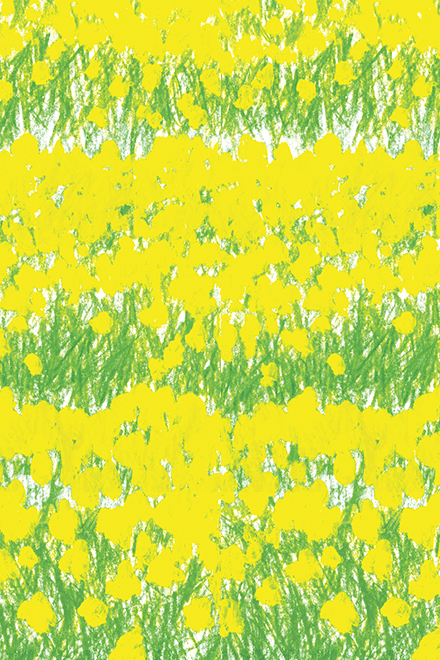
畑の間に点々と菜の花畑の黄色が
あるのは、まさに春の彩りといえる。
菜の花や 月は東に 日は西に
という蕪村の句は、のどかな春の
幸せな気持を感じさせてくれる。
(脇阪 克二)
"Spring breeze"(2011,by Katsuji Wakisaka)
The yellow of rape blossoms dotting in the field,
Describing a landscape of colorful spring.
This sight reminds me a haiku poem by Yosa Buson:
“Rape-flower fields / rising moon in the east / sinking sun in the west”
The calm and gentle spring brings us feelings of happiness.
| English translation by LI XIAO XIAO |
"Brise printanière"(2011, par Katsuji Wakisaka)
Le jaune des parterres de colza parsemant les champs est une preuve supplémentaire du printemps, peut-on dire.
“Fleurs de colza, Lune d’Est, Soleil d’Ouest”
Ce poème de Buson nous rappelle le bonheur calme et doux que nous apporte le printemps.
| Traduction française par Jean-Baptiste Fauvel Matsumoto |
"春風"(2011, 胁阪 克二)
春日田間的青綠中,
閃著油菜花的點點金黃。
這片景象讓我聯想到与謝蕪村的一首俳句:
『春至鄉村煙霧中,
一片金黃油菜花,
朦日西下朦月出。』
春的色彩吹來一陣拂面的暖意。
| 中译 : 李 瀟瀟 |
→こちらのテキスタイルデザイン商品
(Textile products with this pattern)
平成29年03月25日 土曜日号
“カタカナ 平成28年”
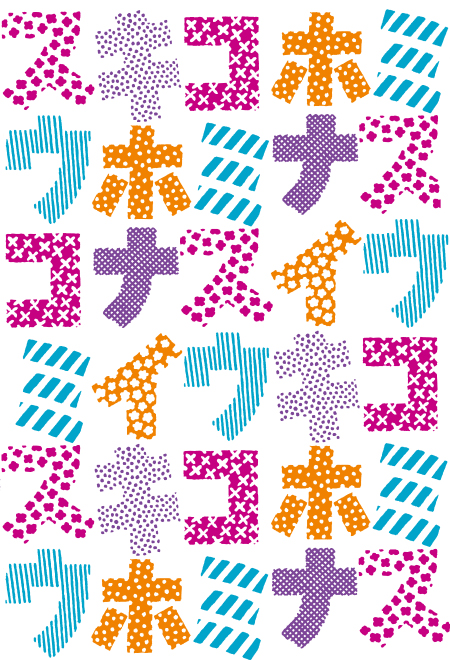

日本人は 漢字から ひらがな、
カタカナを創り出してきた。
ひらがなは それ自体で
美的に使われる様になった。
一方 カタカナは漢字を補足する
ことなど 記号的性格が強い。
しかし アルファベットの様に
直線と曲線で構成され
ポップでかわいい感じがする。
(脇阪 克二)
"Katakana"(2016,by Katsuji Wakisaka)
Japanese produced hinagara and katakana based on the Kanji.
While hinagara has a beautiful calligraphy style,
Katakana has a strong symbolic character.
However, resembling to the English alphabet,
Katakana consists of straight lines and curves,
Showing its pop and delightfully cute appearance
| English translation by LI XIAO XIAO |
"Katakana"(2016, par Katsuji Wakisaka)
Les japonais ont élaboré les katakana
À partir des hiragana, dérivés des kanji.
Les hiragana sont aujourd’hui utilisés
Comme tel, de manière esthétique.
D’un autre côté, les katakana, qui
Complémentaire aux nombreux kanji
Ont un caractère symbolique fort.
Cependant, à l’image des lettres de l’alphabet,
Ils sont faits de lignes droites et courbes,
Leur conférant un esprit pop très mignon.
| Traduction française par Jean-Baptiste Fauvel Matsumoto |
"片假名"(2016, 胁阪 克二)
日本人從漢字演化創造了平假名和片假名。
平假名來源于草書,流暢而美,
相比之下片假名更側重記號性。
片假名和英文字母ABCD一樣,
由直線和曲線組合而成,
雖然有棱有角,但也活潑可愛。
| 中译 : 李 瀟瀟 |
→こちらのテキスタイルデザイン商品
(Textile products with this pattern)
平成29年03月22日 水曜日号
“ほのぼの 平成20年”
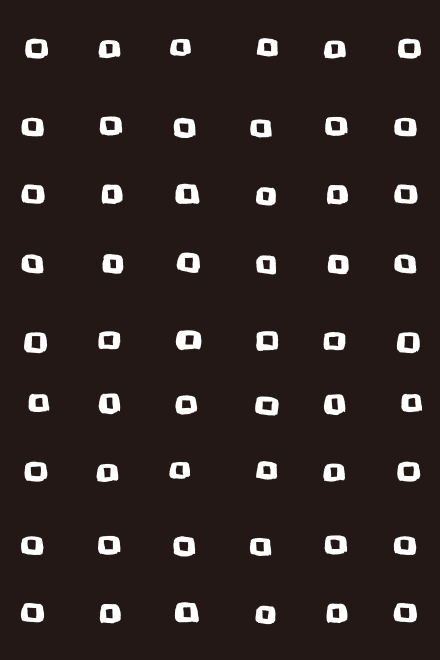
筆にたっぷり絵の具をつけてやわらかい気持ちで四角を描く。
肩の力を抜いて、でも気持ちは集中してゆっくり描く。
ひとつ描いて空間をとって又ひとつ描く。
並んでいる様に描いていても少しずつずれてくる。
ほのぼのしていて面白い。
(脇阪 克二)
"Honobono / Heartwarming"(2008,by Katsuji Wakisaka)
With a brush imbibed with paint, I delicately drew a square.
Relaxed but concentrated,
I finished it leisurely, leave a space, and drew another one.
These little squares tilted slightly even though I attempt to align them.
Simple and fascinating, with a mild warmth.
| English translation by LI XIAO XIAO |
"Apaisé"(2008, par Katsuji Wakisaka)
Avec un pinceau imbibé de peinture, je dessine délicatement un carré.
Relaxé mais concentré, je dessine sereinement.
Une fois fini, je laisse un espace et en réalise un autre.
Même si j'ai essayé de les aligner, ils sont légèrement excentrés.
Simple et fascinant.
| Traduction française par Jean-Baptiste Fauvel Matsumoto |
"暖暖"(2008, 胁阪 克二)
我握起沾滿顏料的畫筆,
手臂放鬆,精神集中,慢慢地輕輕地畫一個小四方形。
畫完一個,隔空再畫一個。
我試圖將這些小四方形整齊地排列,
畫著畫著卻自然地偏離。
完成的這幅紋樣意外地有趣,溫暖而動人。
| 中译 : 李 瀟瀟 |
→こちらのテキスタイルデザイン商品
(Textile products with this pattern)
平成29年03月18日 土曜日号
“離宮 平成元年”
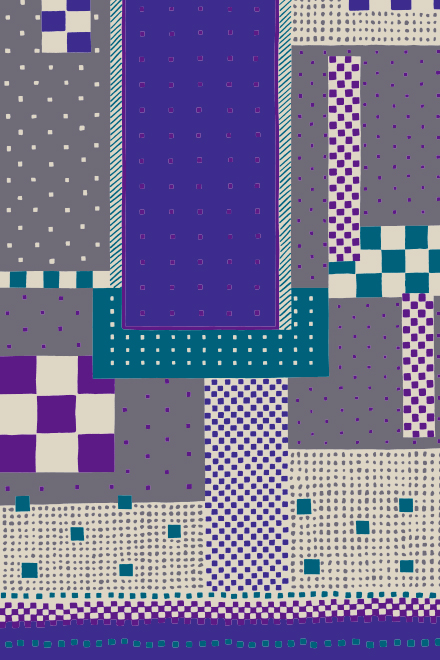
天皇や貴族のために
建てられたものだが
別荘として使われていた。
皇居とか宮殿のような
格式の高さはないかもしれないが
隅々まで個人的な趣味で
作り込まれている。
今の時代にはとても作れない。
(脇阪 克二)
"Rikyū / Imperial villa"(1989,by Katsuji Wakisaka)
Rikyū was built for the emperor and the nobilities as a villa.
Maybe it doesn't have the grandeur of the palace,
But there is an individual beauty,
Though which you can know about the architect who built them.
For this, hardly did I think it possible to build rikyū in the modern age.
| English translation by LI XIAO XIAO |
"La Villa Impériale"(1989, par Katsuji Wakisaka)
Édifiée pour l'empereur et la noblesse,
La villa servait de résidence secondaire.
Elle ne possède pas la grandeur du palais
impérial ou des palais et châteaux européens.
Cependant, elle est construite entièrement
en fonction de goûts personnels.
Impossible à produire de nos jours…
| Traduction française par Jean-Baptiste Fauvel Matsumoto |
"離宮"(1989, 脇阪 克二)
離宮是爲日本天皇或貴族所建的別墅。
雖然並不像皇居或宮殿一般高貴氣派,
但它的設計細節融入了很多獨特的個人風格。
這樣的建築是當今時代難以創造的。
| 中譯 : 李 瀟瀟 |
→こちらのテキスタイルデザイン商品
(Textile products with this pattern)
平成29年03月16日 木曜日号
“植物園 平成22年”
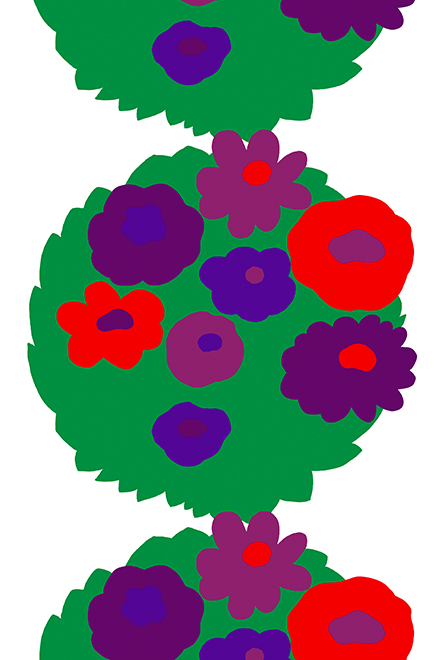
緑がいっぱいの植物園。
目に入ってくるものは
心地よい緑、緑、緑。
その中に色鮮かな花が咲いている。
植物園は花と緑の国。
(脇阪 克二)
"Botanical garden"(2010,by Katsuji Wakisaka)
Botanical garden,
Filled with refreshing green,
Embellished with brightly colored flowers.
Botanical garden,
A valley of flowers and natural green.
| English translation by LI XIAO XIAO |
"Jardin botanique"(2010, par Katsuji Wakisaka)
Un jardin botanique rempli de vert.
Tout ce qui rentre dans notre champ de vision,
C’est de la verdure et encore de la verdure.
A l’intérieur, une fleur éclatante s’épanouie.
Le jardin botanique est le royaume des fleurs et de la verdure.
| Traduction française par Jean-Baptiste Fauvel Matsumoto |
"植物園"(2010, 胁阪 克二)
植物園充滿了綠色。
滿眼都是舒心的綠,綠,綠。
其中開一些鮮豔的花。
植物園就是一處花和綠的國度。
| 中译 : 李 瀟瀟 |
→こちらのテキスタイルデザイン商品
(Textile products with this pattern)
平成29年03月11日 土曜日号
“菜の花 平成26年”
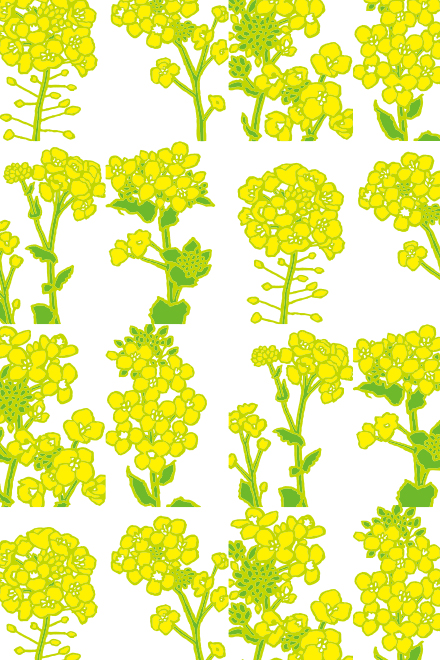
菜とは食用の意味で菜の花とは食用の花。
まだ寒い時期から黄色い花を咲かせた
菜の花が野菜売場に並ぶ。
その明るい黄色と少し苦味のある味が
食卓に春を運んでくる。
(脇阪 克二)
"Nanohana"(2014,by Katsuji Wakisaka)
"Na" of nanohana in Japanese implies "edible"
and "nanohana" means briefly "edible flower".
From the season it is still cold
nanohana (canola flower) with blooming little yellow flowers,
show up in vegetable stores.
The brightness of its yellow and little bit bitter taste
bring spring to our dinning table.
| English translation by LI XIAO XIAO |
"Nanohana"(2014, par Katsuji Wakisaka)
“Na” signifie comestible et “Hana” fleur, ce qui peut être traduit par “fleur comestible”. En cette saison encore froide, les nanohana décorent les fleuristes de leur petite fleur jaune. La clarté de ses couleurs et son goût un peu amer Amène sur nos tables le printemps.
| Traduction française par Jean-Baptiste Fauvel Matsumoto |
"菜花"(2014, 胁阪 克二)
“菜”有可供食用的意思,
菜花指可食用的花。
菜花在初春尚寒的時節開出明燦燦的黃花,
擺在蔬菜市場也甚爲亮眼。
那一抹明亮的金黃和微苦的味道,
宣示著餐桌上春的到來。
| 中译 : 李 瀟瀟 |
→こちらのテキスタイルデザイン商品
(Textile products with this pattern)
平成29年03月08日 水曜日号
“春一番 平成21年”
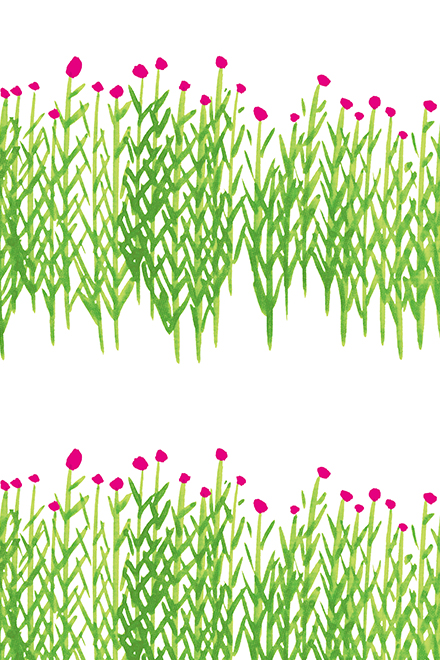
まだ少し肌寒い春の風にさそわれて外に出ると、
暖かな日差しの中に小さな赤い花がいっぱい咲いている。
点々と並んで背くらべをするように、
競い合って大きくなろうとしている。
野の花のたくましさ可憐さに、
生きていることはこういうことだと教えられる。
(脇阪 克二)
"Spring here!"(2009,by Katsuji Wakisaka)
I took a walk in early spring,
The cold breeze blows gently,
A number of little red flowers blossom in the bright sunshine,
Straightening their back to see who is the tallest.
Wild flowers,
Thriving on competition,
Grow up healthy and strong,
Teaching us the meaning of life.
| English translation by LI XIAO XIAO |
"Voilà le printemps!"(2009, par Katsuji Wakisaka)
Invité par le vent printanier encore frais,
je sors faire un tour et suis accueilli par
une multitude de petites fleurs rouges épanouies.
Comme si elles comparaient leur taille,
elles entrent en compétition et s'efforcent de se grandir.
À l'image des fleurs si frêles et si fortes,
Elles nous enseignent le sens de la vie.
| Traduction française par Jean-Baptiste Fauvel Matsumoto |
"初春的風"(2009, 胁阪 克二)
初春散步,風微涼。
一叢小小的紅色花朵星星點點地開在陽光下。
並排著比這高矮,爭先恐後地生長。
小野花旺盛而可愛,
教會我們生命的意義。
| 中译 : 李 瀟瀟 |
→こちらのテキスタイルデザイン商品
(Textile products with this pattern)
平成29年03月04日 土曜日号
“染付け 平成23年”

素焼の磁器に呉須という顔料で絵付け。
その上に釉薬をかけて焼き上げる。
白く艶のある地に濃淡のある青で
味わいのある模様が絵描かれている。
染付けは日本の食器の
代表的なもののひとつだ。
(脇阪 克二)
"Sometsuke / Blue glaze"(2011,by Katsuji Wakisaka)
Sometsuke, or blue and white pottery is white porcelain painted by gosu or zaffer, and decorated with blue under the glaze.
Classically beautiful patterns are painted in a range of tones of blue on bright white base.
Sometsuke is one of the representative tableware of Japan.
| English translation by LI XIAO XIAO |
"Sometsuke / Teinture"(2011, par Katsuji Wakisaka)
La technique Sometsuke est le procédé de teinter
De la porcelaine blanche avec des pigments appelés gosu.
Le tout est ensuite glacé et cuit.
De manière classique, de magnifiques motifs sont peints
dans différents tons de bleu sur une base blanche.
Le Sometsuke est une des vaisselles représentatives du Japon.
| Traduction française par Jean-Baptiste Fauvel Matsumoto |
"染付"(2011, 胁阪 克二)
染付,是日本陶瓷界對青花瓷器的稱呼。
用青料進行色繪曰“染”;付,即紋飾。
染付即在晶瑩潔白的坯體上,
用濃淡層次分明的青料色繪紋飾。
染付磁器是日本的代表性食器之一。
| 中译 : 李 瀟瀟 |
→こちらのテキスタイルデザイン商品
(Textile products with this pattern)
平成29年03月01日 水曜日号
“おはじき大 平成18年”
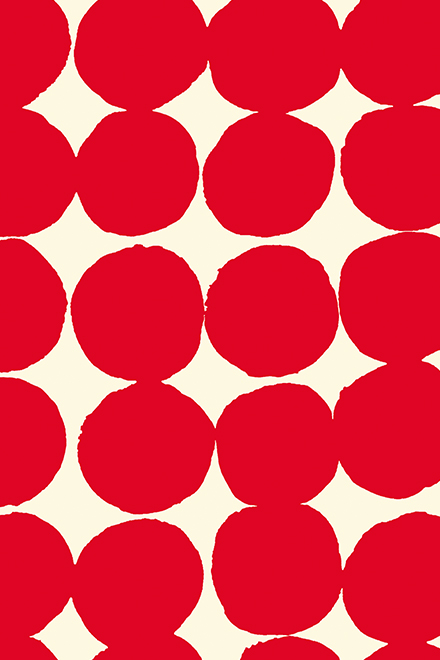
おはじきはかわいいデザインですが、
大柄のものはとても大らかで
ゆったりしている。
ホッとする暖かい雰囲気が出てきたことは不思議に思う。
(脇阪 克二)
"Large marbles"(2004,by Katsuji Wakisaka)
Ohajiki, Flattened marbles,
Small and cute.
I draw some large marbles,
Finding that they are having surprisingly different mood,
Gentle, warm and broad-minded.
| English translation by LI XIAO XIAO |
"Jeu de puce"(2004, par Katsuji Wakisaka)
Les petits marbres plats ont de bien jolis designs mais
À grande échelle, ils sont imposants et tranquilles.
Cette air doux et calme en ressortant est étrange.
| Traduction française par Jean-Baptiste Fauvel Matsumoto |
"彈珠"(2004, 胁阪 克二)
彈珠原本小巧可愛,
而放大版的彈珠紋樣,
顯得悠悠然,暖洋洋的,
真是不可思議。
| 中译 : 李 瀟瀟 |
→こちらのテキスタイルデザイン商品
(Textile products with this pattern)
平成29年02月25日 土曜日号
“律 平成28年”
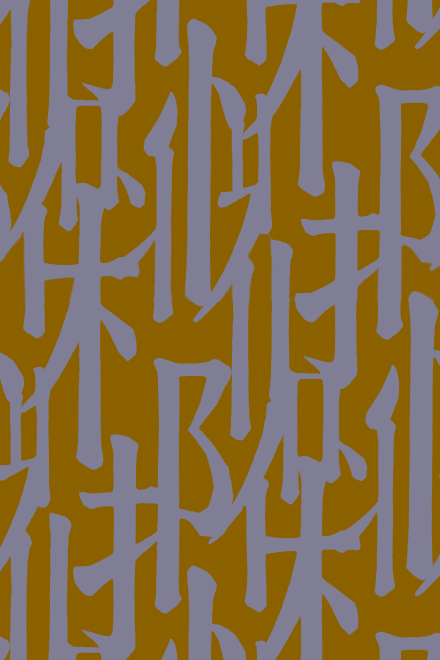

漢字は偏(へん)、旁(つくり)、冠(かんむり)など
いくつかの部分で構成されている。
偏だけを使って 縞模様のような
柄をつくる。
漢字独特の強弱やリズムが
ある心地良さと 施律をかなでてくる。
規律の中の美しさとも言える。
人も自分自身を律して生きると
美しい。
(脇阪 克二)
"Ritsu / Rhythm"(2016,by Katsuji Wakisaka)
Kanji, or Chinese character, are made of hundreds of radicals.
I picked a radical to made this stripe-looking textile design.
Kanji has their unique rhythm, which makes me feel pleasant.
That’s the same as individual.
People who follow their own rhythm are outstandingly beautiful.
| English translation by LI XIAO XIAO |
"Ritsu / Rythme "(2016, par Katsuji Wakisaka)
Les Kanji, caractère d’origine chinoise, sont construits à partir de nombreuses clés. J'ai utilisé la clé hen 偏 afin de créer ce motif en forme de bandes. Il existe un rythme unique à chaque caractère, Une mélodie apaisante et réconfortante. Une sorte de beauté dans la discipline, pourrait-on dire. Les personnes qui suivent leur propre rythme sont également ravissantes.
| Traduction française par Jean-Baptiste Fauvel Matsumoto |
"律"(2016, 胁阪 克二)
漢字由偏旁,部首,字頭等部分構成,
我只取「偏旁」這個元素,
將其設計成條文花樣的3月織紋。
漢字有它獨特的強弱和律動,
規律中含有一種舒暢人心的韻律美。
人也是如此,
擁有自身獨特節奏律動的人很美。
| 中译 : 李 瀟瀟 |
→こちらのテキスタイルデザイン商品
(Textile products with this pattern)
平成29年02月18日 土曜日号
“きくまる 平成20年”
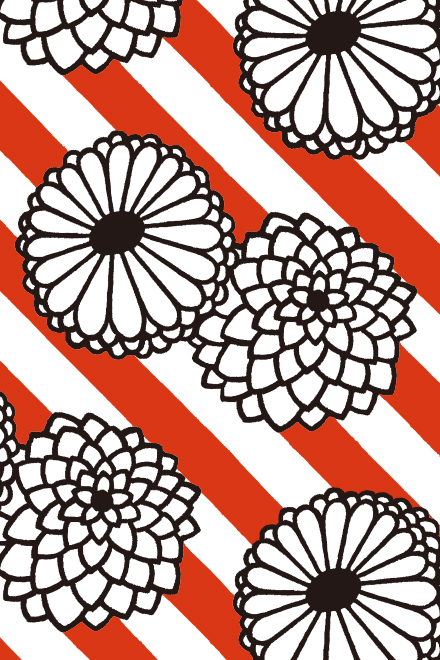
昔の着物の模様は、今の日本人の意識では
考えられないほど大胆なものが多い。
今よりずっと精神が自由でいきいきしていた。
そんな時代への憧れを菊と縞に託して。
(脇阪 克二)
"Kikumaru / Striped mums"(2013,by Katsuji Wakisaka)
According to modern Japanese aesthetics, some of ancient kimono patterns can be deemed bold.
They are daring, far beyond our imagination, showing the active and creative thought.
I long for the old-style and project that into the chrysanthemums and stripes of this textile.
| English translation by LI XIAO XIAO |
"Kikumaru"(2013, par Katsuji Wakisaka)
D'après l’esthétique moderne japonaise, certains ancient motifs de Kimono peuvent être considéré comme osé. Ils sont audacieux, plus que de raison, et représente des idées actives et créatives. J'ai transcrit mon attrait pour cette époque lointaine en incorporant des chrysanthèmes et des bandes à ce textile.
| Traduction française par Jean-Baptiste Fauvel Matsumoto |
"菊丸"(2013, 胁阪 克二)
按照現代日本人的審美標准,
舊時和服的花紋是大膽的。
那份明朗鮮活更能體現一種精神自由。
我把對古風的憧憬寄托在了這些菊花紋樣裏。
| 中译 : 李 瀟瀟 |
→こちらのテキスタイルデザイン商品
(Textile products with this pattern)
- コメント
-
あるブログで紹介されていた記事を読ませていただきました。
--------------------------------------------------—
「一日一信」は、17年間、欠かさず続けてきた習慣だ。
朝食後、机に向かい郵便はがきに一枚の絵を描く。
そして妻宛に投函する。 〜 季刊『銀花』第153号
--------------------------------------------------—
心に響きました。
ああ、なんて素敵なんだろう。
ただただそう思うと、何故か自分が奥様になったように錯覚して嬉しさいっぱいの気持ちになるのです。
昨年はじめてSOU・SOUさんを知り、それ以来脇坂さんのデザインされた手ぬぐい等も日々の生活に取り入れています。
これからも地方のこの場所で、脇坂さんのテキスタイルをSOU・SOUを愉しんでいけたら、と思っています。
金沢のS.K.様
僕はあたりまえに日常で使われるテキスタイルデザインを作りつづけたいと思っています。
末永く使ってやって下さい。
- 最近書いた記事
- 関連記事
-
平成29年02月15日 水曜日号
“金平糖 平成25年”
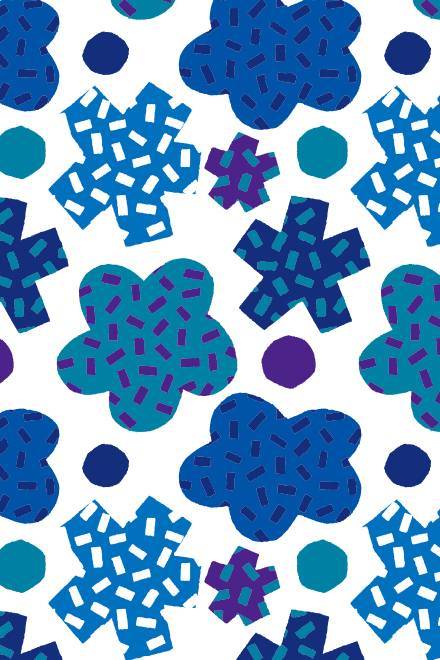
回転する円形の鉄の大鍋に砂糖と下味のついた水を入れ
温めながら根気よくかきまぜていくことで出来る金平糖。
作っていく段階で角(つの)のようなものがいくつも出来て
あの不思議な形になる。
舌に触れる感じとほのかな甘さがいい。
金平糖の語源はポルトガル語だそうだが
その言葉のひびきも魅力のひとつだと思う。
(脇阪 克二)
"Konpeitō / Confetti candy"(2013,by Katsuji Wakisaka)
Mix sugar with pre-seasoned water,
Heat it in a giant circular rotating tub,
Keep stirring constantly, the Konpeitō finally complete.
These tiny candies are shaped into miraculous stars during the process.
Their unique texture and soft sweet flavor are amazing.
"Konpeitō" comes from Portuguese word "Confeito" (a type of sugar candy),
The sound of the word was fascinating to me.
| English translation by LI XIAO XIAO |
"Konpeito / Etoile sucrée"(2013, par Katsuji Wakisaka)
Dans un chaudron rond en acier, ajoutez du sucre et de l’eau aromatisée.
Mélangez avec patience tout en chauffant le tout. Et la voilà: l’étoile sucrée.
A mesure de sa préparation, de petites cornes se forment tout autour
Et elle prend cette forme si particulière.
Cette douceur sucrée qui fond sur la langue est savoureuse.
L’origine du nom “Konpeito” est paraît-il portugaise.
Le nom du bonbon en lui-même est attrayant.
| Traduction française par Jean-Baptiste Fauvel Matsumoto |
"金平糖"(2013, 胁阪 克二)
金平糖的做法是在可旋轉的巨型炒鍋中加熱糖水,
並用鐵鏟不停地鏟動讓水分蒸發將糖分裹在芯料外而成。
外形似球形的珊瑚,小巧別致。
金平糖不僅有獨特的口感和淡淡的甜味,
它的名字是葡萄牙語"confeito"的音譯,
其音韻也是魅力獨具。
| 中译 : 李 瀟瀟 |
→こちらのテキスタイルデザイン商品
(Textile products with this pattern)











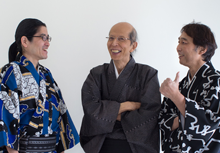

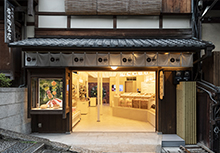

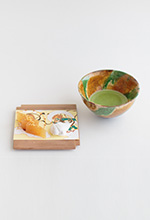
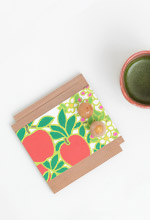
 お問い合わせ窓口
お問い合わせ窓口
いつも見せてもらってたのしんでいます。
これも高貴な色紫を使って丸と四角だけで表現してあり素晴らしいですね。
色の組み合わせ 柄の組み合わせが素晴らしいと思います。
島津様
何を以て美とするか、の最も簡素で究極なものがそこにありそうな気がしました。